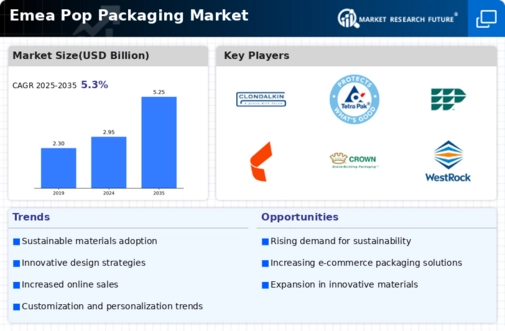Market Growth Projections
The Global Emea Pop Packaging Market Industry is poised for substantial growth, with projections indicating a compound annual growth rate (CAGR) of 5.39% from 2025 to 2035. This growth trajectory suggests a robust demand for innovative packaging solutions across various sectors, including food and beverage, cosmetics, and pharmaceuticals. The market is expected to reach 5.25 USD Billion by 2035, driven by factors such as technological advancements, sustainability initiatives, and changing consumer preferences. Companies that strategically position themselves to capitalize on these trends may find lucrative opportunities in this expanding market.
Health and Safety Regulations
Health and safety regulations play a crucial role in shaping the Global Emea Pop Packaging Market Industry. Stringent guidelines regarding food safety and packaging materials are being enforced across various countries. These regulations ensure that packaging materials do not compromise product safety and quality. Compliance with these standards is essential for companies aiming to maintain market access and consumer trust. As the industry adapts to these regulations, investments in safer packaging materials and processes are likely to increase. This focus on health and safety not only protects consumers but also enhances the overall reputation of brands within the market.
Sustainable Packaging Initiatives
The Global Emea Pop Packaging Market Industry is increasingly influenced by the shift towards sustainable packaging solutions. As consumers become more environmentally conscious, companies are adopting eco-friendly materials and practices. For instance, the use of biodegradable plastics and recycled materials is on the rise. This trend is not only driven by consumer demand but also by regulatory pressures aimed at reducing plastic waste. The market is projected to reach 2.95 USD Billion in 2024, reflecting a growing commitment to sustainability. Companies that prioritize sustainable packaging are likely to gain a competitive edge, appealing to a broader customer base and enhancing brand loyalty.
Consumer Preferences for Aesthetics
Consumer preferences are increasingly influencing the design aspects of the Global Emea Pop Packaging Market Industry. Attractive and innovative packaging designs are essential for capturing consumer attention in a crowded marketplace. Brands are investing in unique shapes, colors, and graphics to differentiate their products. This focus on aesthetics is not merely superficial; it can significantly impact purchasing decisions. Research indicates that well-designed packaging can enhance perceived product value and encourage impulse buying. As competition intensifies, companies that prioritize aesthetic appeal in their packaging strategies may experience improved sales and brand recognition.
Rising Demand for Convenience Products
The Global Emea Pop Packaging Market Industry is witnessing a surge in demand for convenience products, driven by changing consumer lifestyles. As urbanization continues to rise, consumers increasingly seek ready-to-eat and on-the-go food options. This trend necessitates innovative packaging solutions that ensure product freshness and portability. For instance, single-serve packaging and resealable options are gaining popularity. The market is expected to grow significantly, with projections indicating a rise to 5.25 USD Billion by 2035. Companies that adapt their packaging strategies to meet the needs of convenience-oriented consumers are likely to thrive in this evolving landscape.
Technological Advancements in Packaging
Technological innovations are reshaping the Global Emea Pop Packaging Market Industry, enabling more efficient and effective packaging solutions. Automation and smart packaging technologies are becoming prevalent, allowing for enhanced product tracking and consumer engagement. For example, the integration of QR codes and NFC technology provides consumers with instant access to product information. These advancements not only improve the user experience but also streamline production processes, potentially reducing costs. As the market evolves, companies that leverage these technologies may experience increased operational efficiency and higher customer satisfaction, contributing to the overall growth of the industry.





















Leave a Comment